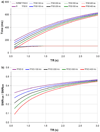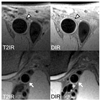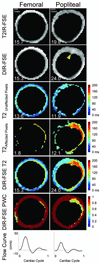Effect of blood flow on double inversion recovery vessel wall MRI of the peripheral arteries: quantitation with T2 mapping and comparison with flow-insensitive T2-prepared inversion recovery imaging
- PMID: 20187182
- PMCID: PMC2921169
- DOI: 10.1002/mrm.22227
Effect of blood flow on double inversion recovery vessel wall MRI of the peripheral arteries: quantitation with T2 mapping and comparison with flow-insensitive T2-prepared inversion recovery imaging
Erratum in
- Magn Reson Med. 2010 Nov;64(5):1540
Abstract
Blood suppression in the lower extremities using flow-reliant methods such as double inversion recovery may be problematic due to slow blood flow. T(2) mapping using fast spin echo (FSE) acquisition was utilized to quantitate the effectiveness of double inversion recovery blood suppression in 13 subjects and showed that 25 +/- 12% of perceived vessel wall pixels in the popliteal arteries contained artifactual blood signal. To overcome this problem, a flow-insensitive T(2)-prepared inversion recovery sequence was implemented and optimal timing parameters were calculated for FSE acquisition. Black blood vessel wall imaging of the popliteal and femoral arteries was performed using two-dimensional T(2)-prepared inversion recovery-FSE in the same 13 subjects. Comparison with two-dimensional double inversion recovery-FSE showed that T(2)-prepared inversion recovery-FSE reduced wall-mimicking blood artifacts that inflated double inversion recovery-FSE vessel wall area measurements in the popliteal artery.
(c) 2010 Wiley-Liss, Inc.
Figures






Similar articles
-
Three-dimensional flow-independent balanced steady-state free precession vessel wall MRI of the popliteal artery: preliminary experience and comparison with flow-dependent black-blood techniques.J Magn Reson Imaging. 2011 Sep;34(3):696-701. doi: 10.1002/jmri.22663. Epub 2011 Jul 18. J Magn Reson Imaging. 2011. PMID: 21769963 Free PMC article.
-
Noncontrast MR angiography for supraaortic arteries using inflow enhanced inversion recovery fast spin echo imaging.J Magn Reson Imaging. 2012 Apr;35(4):957-62. doi: 10.1002/jmri.23515. Epub 2011 Nov 29. J Magn Reson Imaging. 2012. PMID: 22127993
-
Improved blood suppression in three-dimensional (3D) fast spin-echo (FSE) vessel wall imaging using a combination of double inversion-recovery (DIR) and diffusion sensitizing gradient (DSG) preparations.J Magn Reson Imaging. 2010 Feb;31(2):398-405. doi: 10.1002/jmri.22042. J Magn Reson Imaging. 2010. PMID: 20099353 Free PMC article.
-
Hyperecho PROPELLER-MRI: Application to rapid high-resolution motion-insensitive T2 -weighted black-blood imaging of the carotid arterial vessel wall and plaque.J Magn Reson Imaging. 2017 Feb;45(2):515-524. doi: 10.1002/jmri.25377. Epub 2016 Jul 8. J Magn Reson Imaging. 2017. PMID: 27392068
-
Optimization of improved motion-sensitized driven-equilibrium (iMSDE) blood suppression for carotid artery wall imaging.J Cardiovasc Magn Reson. 2014 Aug 9;16(1):61. doi: 10.1186/s12968-014-0061-5. J Cardiovasc Magn Reson. 2014. PMID: 25160911 Free PMC article.
Cited by
-
Simultaneous bilateral magnetic resonance imaging of the femoral arteries in peripheral arterial disease patients.J Magn Reson Imaging. 2011 Jul;34(1):150-6. doi: 10.1002/jmri.22591. Epub 2011 May 19. J Magn Reson Imaging. 2011. PMID: 21598344 Free PMC article.
-
Vessel wall MR imaging in neuroradiology.Radiol Med. 2022 Sep;127(9):1032-1045. doi: 10.1007/s11547-022-01528-y. Epub 2022 Jul 30. Radiol Med. 2022. PMID: 35907157 Free PMC article. Review.
-
Three-dimensional flow-independent balanced steady-state free precession vessel wall MRI of the popliteal artery: preliminary experience and comparison with flow-dependent black-blood techniques.J Magn Reson Imaging. 2011 Sep;34(3):696-701. doi: 10.1002/jmri.22663. Epub 2011 Jul 18. J Magn Reson Imaging. 2011. PMID: 21769963 Free PMC article.
-
Intracranial vessel wall lesions on MRI: anatomical and pathological issues.Neurol Sci. 2025 Jul 16. doi: 10.1007/s10072-025-08366-6. Online ahead of print. Neurol Sci. 2025. PMID: 40668467 Review.
-
Impact of T2 decay on carotid artery wall thickness measurements.J Magn Reson Imaging. 2013 Jun;37(6):1493-8. doi: 10.1002/jmri.23856. Epub 2012 Nov 21. J Magn Reson Imaging. 2013. PMID: 23172683 Free PMC article.
References
-
- Amarenco P, Cohen A, Tzourio C, Bertrand B, Hommel M, Besson G, Chauvel C, Touboul PJ, Bousser MG. Atherosclerotic disease of the aortic arch and the risk of ischemic stroke. N Engl J Med. 1994;331(22):1474–1479. - PubMed
-
- Smilde TJ, van den Berkmortel FW, Boers GH, Wollersheim H, de Boo T, van Langen H, Stalenhoef AF. Carotid and femoral artery wall thickness and stiffness in patients at risk for cardiovascular disease, with special emphasis on hyperhomocysteinemia. Arterioscler Thromb Vasc Biol. 1998;18(12):1958–1963. - PubMed
-
- Demarco JK, Rutt BK, Clarke SE. Carotid plaque characterization by magnetic resonance imaging: review of the literature. Top Magn Reson Imaging. 2001;12(3):205–217. - PubMed
-
- Underhill HR, Yuan C, Zhao XQ, Kraiss LW, Parker DL, Saam T, Chu B, Takaya N, Liu F, Polissar NL, Neradilek B, Raichlen JS, Cain VA, Waterton JC, Hamar W, Hatsukami TS. Effect of rosuvastatin therapy on carotid plaque morphology and composition in moderately hypercholesterolemic patients: a high-resolution magnetic resonance imaging trial. Am Heart J. 2008;155(3):584, e581–e588. - PubMed
Publication types
MeSH terms
Grants and funding
LinkOut - more resources
Full Text Sources

